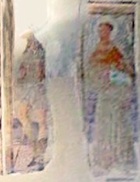

Matteo di Pietro di ser Bernardo, who is better known as Matteo da Gualdo, was born in what is now Gualdo Tadino and based here throughout his life. He held civic office in the city in 1485, 1487 and 1492. He added a codicil to his will in January 1507 and probably died soon after. All his surviving works are thought to have originated in his native city or those close by, including Assisi and Nocera Umbra.
His son Girolamo (died after 1515) and grandson Bernardo (died after 1532) were also artists in Gualdo Tadino.
Gualdo Tadino
Pinacoteca Comunale
The following works by or attributed to Matteo da Gualdo are in the Pinacoteca Comunale.
Madonna and Child with saints (1462)
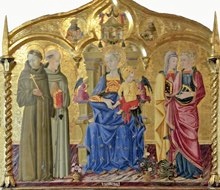
This altarpiece from the Franciscan nunnery of Santa Margherita is the earliest surviving signed and dated work by Matteo da Gualdo. It depicts the Madonna and Child with angels and flanked by SS Francis, Bernardino of Siena and SS Margaret of Antioch and Catherine of Alexandria. SS Bonaventure and Louis of Toulouse in tondi above, flank a tondo containing a tabernacle: this probably alludes to the role of the Madonna as a tabernacle housing the unborn Christ during her pregnancy..
Madonna and Child with saints (1471)
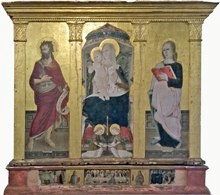
This altarpiece, which is signed by Matteo da Gualdo and dated by inscription, was documented in the Monastero di San Nicolò in 1871, as it was about to enter the civic collection. Its original location is unknown. It depicts Madonna and Child with angels and SS John the Baptist and John the Evangelist. The predella panels depict:
-
✴the Baptism of Christ by St John the Baptist;
-
✴the Last Supper; and
-
✴St John the Evangelist raising the widow Drusiana from the dead.
Madonna and Child with saints (1477)
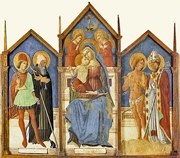
This altarpiece from the parish church of Santa Maria di Pastinaria is dated by inscription and attributed to Matteo da Gualdo. It depicts:
-
✴the Madonna and Child enthroned, with angles flanked a Crucifix in a tondo above:
-
✴SS Secundus and Antony Abbot, on the left; and
-
✴St Sebastian and a bishop saint, on the right.
Santa Maria di Pastinaria was a possession San Secondo, Gubbio, which accounts for the presence of St Secundus and suggests that the bishop saint is probably St Ubaldus.
Processional Banner (1496)
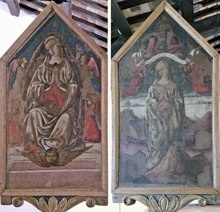
This double-sided banner, which came from Santa Maria Assunta di Nasciano, is attributed to Matteo da Gualdo. The date is known from an inscription that is now illegible. The sides depict, respectively:
-
✴the Assumption of the Virgin; and
-
✴the Immaculate Virgin.
Triptych (1480)
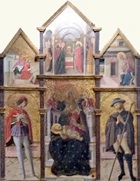
-
✴The main panels depict:
-
•the Madonna and Child enthroned, with angels;
-
•St Sebastian, on the left; and
-
•St Roch, on the right.
-
✴The smaller, upper panels depict the Presentation at the Temple, flanked by figures of the Annunciation.
Genealogy of the Virgin (1497)
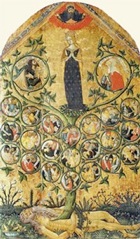
Annunciation (15th century)
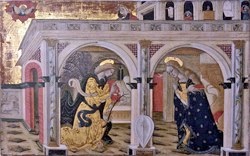
This panel from from SS Annunziata is attributed to Matteo da Gualdo.
San Francesco
The following frescoes, which were recovered during the restoration of San Francesco in 1955-60, are by or attributed to Matteo da Gualdo.
Madonna and Child with St Anne (15th century)
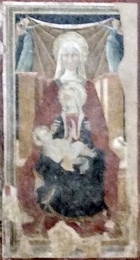
Volto Santo (1474)
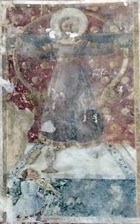
Stigmatisation of St Francis (1496)
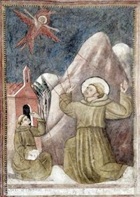
Other Frescoes attributed to Matteo da Gualdo (15th century)
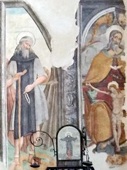
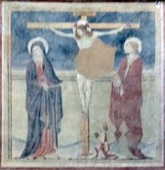

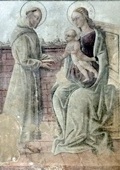
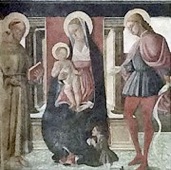
Other frescoes, which are attributed to Matteo da Gualdo, include:
-
✴St William of Maleval (or perhaps St Antony Abbot), who stands on a dragon and the adjacent fragment of a representation of the Trinity (1);
-
✴the Crucifixion with the Virgin and St John the Evangelist and a kneeling male donor (10), although the attribution here is tentative;
-
✴St Nicholas of Tolentino (16), which is missing its head, (although this work is not included in the catalogue of Sara Giuliani Spurney, referenced below);
-
✴St Francis presenting the Franciscan Rule to the Madonna and Child (17)
-
✴the Madonna and Child enthroned with SS Francis and Secundus, with a kneeling male donor (23).
Frescoes (15th century)
The few surviving and damaged fragments of votive frescoes in San Rocco include the following that are attributed to Matteo da Gualdo:
-
✴the Madonna and Child enthroned, in which the baby Jesus holds a bunch of grapes; and
-
✴the Madonna and Child and St Sebastian.
SS Roch and Antony of Padua (15th century)
Assisi
Frescoes (1468)
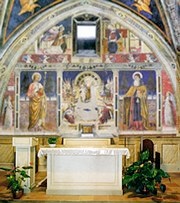
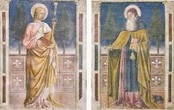
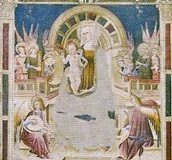
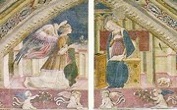
These frescoes on the altar wall of the Oratorio dei Pellegrini are signed by Matteo da Gualdo in the painted tablet on the left and dated by inscription. They depict:
-
✴the Madonna and Child with musical angels (badly damaged);
-
✴St James (on the left) and St Antony Abbot (on the right); and
-
✴the Annunciation (above).
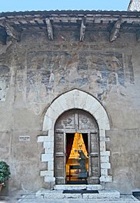
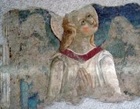
Madonna and Child with saints (ca. 1468)

This altarpiece depicts the Madonna and Child with musical angels and SS Peter and Victorinus. It is signed by Matteo da Gualdo and dated 14... in the inscription on the throne. (The date of 1468 is assumed on stylistic grounds, with reference to Matteo’s securely dated frescoes in the Oratorio dei Pellegrini - see above). The inscription under the throne records the name of the donor, Abbot Bartolomeo.
The altarpiece was first documented in 1872 [in San Pietro]. It was exhibited in Perugia in 1907, but was substituted, perhaps during the exhibition, by a good copy. The original was recovered from a private collection in Rome in 1912. It was then returned to San Pietro and placed in the monastery chapel. It is now in the Museo di San Pietro.
God the Father (15th century)
This damaged fresco by Matteo da Gualdo from the Oratorio di San Crispino is now in the Pinacoteca Comunale.
Works in the Museo Diocesano
Two works in Museo Diocesano are attributed to Matteo da Gualdo:
-
✴three fragments of the frescoes (ca. 1470) of a niche in a house that was used by the Confraternita del Sacramento, which depict:

-
•the Madonna and Child;
-
•St Antony Abbot; and
-
•St Francis; and
-
✴a triptych (ca. 1475) from the church of Santa Maria delle Grazie, Castello di Palazzo (outside Assisi), which depicts the Madonna and Child with musical angels and SS Francis and Sebastian.
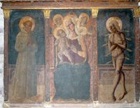
Madonna and Child (1475)

[Crucifixion with the Virgin ad St John the Evangelist (15th century)
This fresco on the altar wall of the chapel in the Rocca Minore is attributed to Matteo da Gualdo]
Crucifix (15th century)
This painted crucifix above the apse of Santa Maria della Rocchicciola (at Rocca Sant’ Angelo, outside Assisi) is attributed to Matteo da Gualdo.
Nocera Umbra
Altarpiece (1490s)
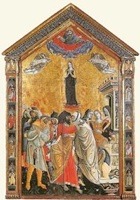
-
✴the meeting of Joachim and Anna at the Golden Gate ,in the lower part;
-
✴the immaculate Virgin with angels, above; and
-
✴God the Father, at the apex of the composition.
The inscription on the Golden Gate, which identifies the saints, also refers to the pontificate of Pope Alexander VI (1492-1503). The chapel belonged to the Olivieri family, and Giovanni Battista Olivieri probably commissioned the altarpiece during his period as Vicar General of Bishop Giacomo Breuquet of Nocera Umbra (i.e. in 1492-8). The iconography celebrates the dogma of the Immaculate Conception of the Virgin, which Pope Sixtus IV had approved in 1477.
The saints in the fictive niches to the sides are identified by inscription as (from the top):
-
✴on the left: SS Paul; Mary Magdalene; Blaise; and Agnes; and
-
✴on the right: SS Raynaldus; Lucy; and Bartholomew; and “BEAT ANGL D NUCER” (Blessed Angelus of Gualdo Tadino ??).
Frescoes
These frescoes in San Francesco (now the Pinacoteca), which are attributed to Matteo da Gualdo, depict:
-
✴in the 4th bay of the right wall:
-
•the Madonna and Child with St John the Baptist (1498), dated by inscription; and
-
•the Annunciation;
-
✴St Antony of Padua, which carries an inscription recording the name of the commissioner, “An[gel]us Marini Massarii” (in the 5th bay of the right wall); and
-
✴St Francis receiving the stigmata (1497), dated by inscription (on the left, in the presbytery).
Perugia
Frescoed aedicule (1488)
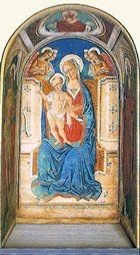
-
✴the Madonna and Child;
-
✴St Sebastian, on the left;
-
✴St Antony Abbot, on the right; and
-
✴God the Father, above.
The scroll in the left of the throne bears the signature of Matteo da Gualdo, and the inscription below the Virgin also has a date, which is probably 1488 (although it could be 1493).
Panels in Palazzo Baldeschi (15th century)
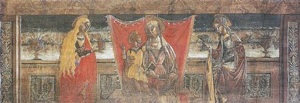
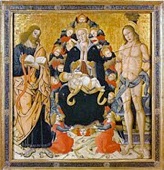
Two panels that are attributed to Matteo da Gualdo form part of the Collection of the Fondazione Cassa di Risparmio di Perugia:
-
✴a damaged panel of the Madonna and Child with SS Mary Magdalene and Lucy, which could have come from the Monastero di SS Lucia e Maria Maddalena in Gualdo Tadino; and
-
✴a panel of the Assumption of the Virgin with SS Thomas and Sebastian, which could have come from the chapel in San Benedetto, Gualdo Tadino that was dedicated to St Thomas in 1488.
Read more:
E. Bairati and P Dragoni (Eds), “Matteo da Gualdo, Rinascimento Eccentrico tra Umbria e Marche”, (2004) Florence
S. Giuliani Spurney, “Matteo da Gualdo”, (1999) Ellera Umbra
Return to Art in: Assisi Gualdo Tadino Nocera Umbra Perugia.
